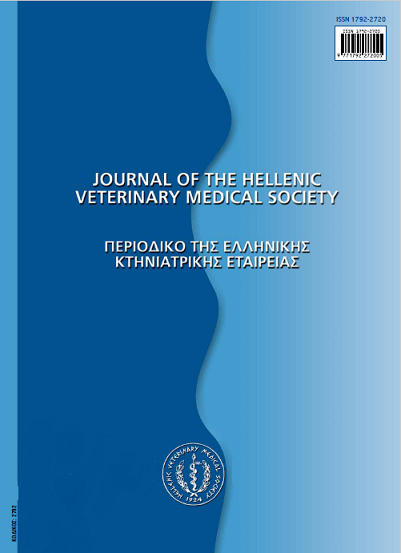Πειραματική αξιολόγηση της προστασίας χοιριδίων με ένα στέλεχος του ίου της Ψευδόλυσσας

Περίληψη
Σκοπός της παρούσας έρευνας ήταν να μελετηθεί ο κλώνος (mAlp) του ίου της Ψευδόλυσσας (pseudorabiesvirus, PrV) ως ανοσογόνος παράγοντας για τη νόσου του Aujeszky's. Η παθογονικότητα, η ανοσογονικότητα και η δυνατότητα προστασίας που προκαλείται από τον ιό είναι οι κύριοι στόχοι της παρούσας μελέτης. Χρησιμοποιήθηκε μια έμεση ELISA γιατον προσδιορισμό των αντισωμάτων του ίου. Το στέλεχος (mAlp) αποδείχθηκε μη παθογόνο για χοιρίδια ηλικίας 3-4 εβδομάδων,στη δόση των 10 plaqueformingunk (p.f.u.). Ο τίτλος των αντισωμάτων στον ιό συγκρίθηκε με τη δόση ανοσοποίησης. Η διαφορά στον τίτλο του ίου για τη δόση ανοσοποίησης των 10 και10 p.f.u. δεν ήταν σημαντική (ρ<0.01), αλλά μεταξύ των δόσεων 10 και 10 ήταν στατιστικά σημαντική (ρ<0.05). Μετά από την πειραματική μόλυνση των ανοσοποιημένων ατόμων με το παθογόνο στέλεχος PrV-CD, παρατηρήθηκε ολική προστασία των χοιριδίων στη δόση ανοσοποίησης των 10 p.f.u. Ως συμπέρασμα προκύπτει ότι το μη παθογόνο στέλεχος PrV-mAlp θεωρείται υψηλής ανοσογονικότητας και προσδίδει υψηλή προστασία έναντι των παθογόνων στελεχών και μπορεί να θεωρηθεί ως ιδανικό εμβολιακό στέλεχος έναντι της νόσου.
Λεπτομέρειες άρθρου
- Πώς να δημιουργήσετε Αναφορές
-
ABDELWAHID, S. A., & ELJALII, I. (2017). Πειραματική αξιολόγηση της προστασίας χοιριδίων με ένα στέλεχος του ίου της Ψευδόλυσσας. Περιοδικό της Ελληνικής Κτηνιατρικής Εταιρείας, 56(4), 307–310. https://doi.org/10.12681/jhvms.15090
- Τεύχος
- Τόμ. 56 Αρ. 4 (2005)
- Ενότητα
- Research Articles
Οι συγγραφείς των άρθρων που δημοσιεύονται στο περιοδικό διατηρούν τα δικαιώματα πνευματικής ιδιοκτησίας επί των άρθρων τους, δίνοντας στο περιοδικό το δικαίωμα της πρώτης δημοσίευσης.
Άρθρα που δημοσιεύονται στο περιοδικό διατίθενται με άδεια Creative Commons 4.0 Non Commercial και σύμφωνα με την άδεια μπορούν να χρησιμοποιούνται ελεύθερα, με αναφορά στο/στη συγγραφέα και στην πρώτη δημοσίευση για μη κερδοσκοπικούς σκοπούς.
Οι συγγραφείς μπορούν να καταθέσουν το άρθρο σε ιδρυματικό ή άλλο αποθετήριο ή/και να το δημοσιεύσουν σε άλλη έκδοση, με υποχρεωτική την αναφορά πρώτης δημοσίευσης στο J Hellenic Vet Med Soc
Οι συγγραφείς ενθαρρύνονται να καταθέσουν σε αποθετήριο ή να δημοσιεύσουν την εργασία τους στο διαδίκτυο πριν ή κατά τη διαδικασία υποβολής και αξιολόγησής της.


